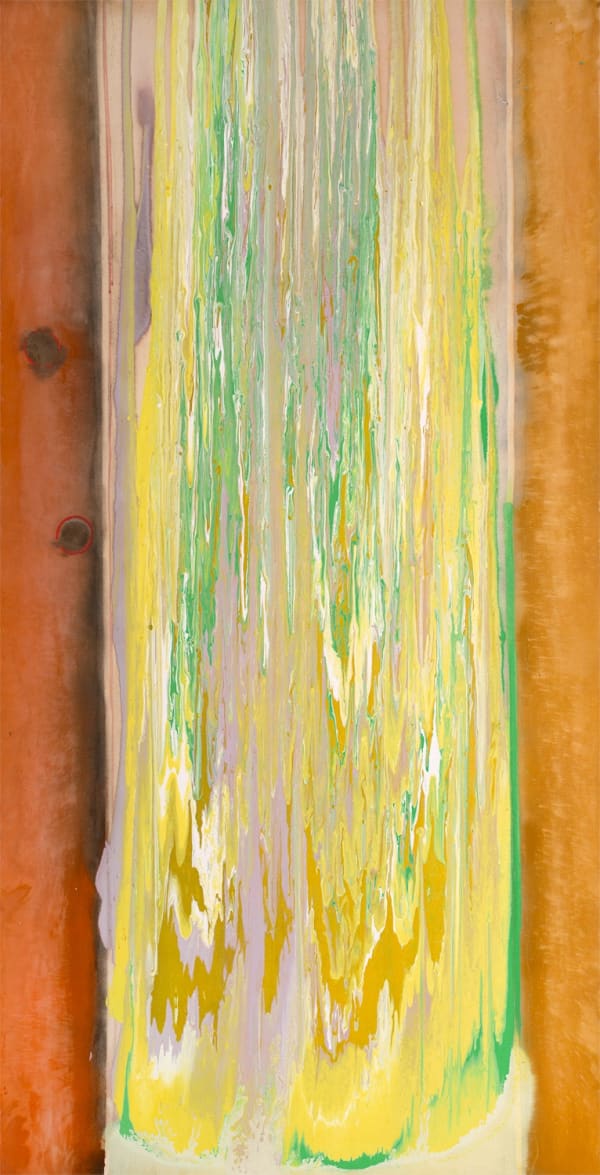Frank Bowling OBE RA: The Poured Paintings
As part of an ongoing series of shows devoted to the career of influential painter Frank Bowling OBE RA (b. 1936 in British Guiana) Hales Gallery is delighted to announce Frank Bowling OBE RA: The Poured Paintings, the artist's fourth solo show with the gallery. The Poured Paintings form one of Bowling's key historic bodies of work.
Bowling began his career as a figurative painter, having been briefly involved in the British Pop Movement of the '50s and '60s. After moving to New York in late 1960s, Bowling’s painting began to turn to abstraction – the field in which his contributions have been most significant. His paintings, which had always inclined towards a frontal geometric structure of space, became more formally complex, guided by principles of mathematics and symmetry. In 1971, Bowling met Clement Greenberg, famous critic, theorist and advocate of abstraction in art. Greenberg became a regular visitor to the artist's studio on Broadway and an important influence to Bowling. His advice and encouragement, alongside Bowling’s ongoing creative dialogue with artists Larry Rivers and Jasper Johns, helped remove any remaining doubts Bowling might have had about his commitment to modernism. Any remaining traces of Pop influences or figurative elements present in his Map Paintings were stripped away, leading to an increasing focus on material, process, and colour.
Working between his New York and London studios, Bowling developed a special mechanical apparatus which tilted the canvas so that he could pour paint onto it, creating spontaneous fusions and layers of colour now known as the Poured Paintings. The result would be a work whose final appearance cannot be ascribed to any intentional intervention on the part of the artist. Before this, Bowling had been working with staining to create a series of atmospheric colour field canvases, but with the tilting mechanism he sought to push further away from the expressionist gesture and towards a process-driven purely abstract object. This resulted in a series of dynamic works which celebrate colour as form and paint as a medium.
At the time, the Poured Paintings were championed by Greenberg and much admired by Bowling’s contemporaries also exploring the possibilities of paint and abstraction. Today, 40 years after their creation, the works remain timely and relevant as reflections of Bowling’s two ongoing and central preoccupations as a painter: colour and process. Bowling allowed himself improvisatory control in terms of colour selection and composition, while restraining himself with the use of the mechanical tilting device. The resulting series plays out like a series of musical variations, with similar compositional symmetry and verticality, but a unique colour identity and tone selected by the artist. The subtlety of Irma Kurtz Visits Broadway is contrasted with the electric colours in Tony’s Anvil; the dark shades of Green Dan oppose the fiery Kathleen. These evocative titles, with their personal allusions and cryptic references, are undercut by the canvases’ strict formalism, which denies any socio-political or historical narrative through which to interpret the image whilst simultaneously emphasising the aesthetic originality and freshness of Bowling’s work.
The Poured Paintings position the artist at the vanguard of ‘post-painterly’ abstract experimentation, working in a community alongside key figures including Larry Poons and Jules Olitski to create works of integrity, complexity and stunning beauty. Their achievement continues to be recognised today, having recently been featured in a solo display at Tate Britain (2012-2013). A 1975 painting from the series, Tambernic Tumbles, part of the Menil Collection in Texas, is also currently on show at the Menil in Affecting Presence and the Pursuit of Delicious Experience, running through November 2015. Other institutional collections featuring the Poured Paintings include the Herbert F. Johnson Museum, Cornell University, Ithaca, New York, the Metropolitan Museum of Art, New York, the Museum of Modern Art, New York, the Neuberger Museum of Art, Purchase, the Museum of Fine Arts, Boston, Massachusetts, the National Gallery of Jamaica, Kingston, The National Museum Wales, Cardiff, and the Government Art Collection, London.
Frank Bowling OBE RA (b. Guyana, 1936) moved to London in 1953, where his artistic career began shortly after his arrival at the Royal College of Art (1959-62). His first solo exhibition, Image in Revolt, was hosted the year Bowling graduated at Grabowski Galleries in London. However, in 1966, Bowling decided to move to New York, aided by his first Guggenheim Fellowship awarded in 1967. The artist has since established studios in both New York and London.
Bowling's paintings have been exhibited widely and internationally. Selected solo shows include Whitney Museum of American Art, New York (1971), Serpentine Gallery, London (1986), and a UK touring retrospective (2003). His work can be found in numerous public and private collections including the Metropolitan Museum of Art (New York), Museum of Modern Art (New York), Museum of Fine Arts (Boston), Dallas Museum of Art (Dallas), Royal Academy of Arts (London), Tate Gallery (London), Victoria & Albert Museum (London), and the Whitney Museum of American Art (New York).
-

Frank Bowling, Kathleen, 1976, acrylic on canvas, 189 x 145 cm, 74 3/8 x 57 1/8 in
-

Frank Bowling, Irma Kurtz Visits Broadway, 1975, acrylic on canvas, 203.5 x 129 cm, 80 1/8 x 50 3/4 in
-

Frank Bowling, Tony's Anvil, 1975, acrylic on canvas, 173 x 107 cm, 68 1/8 x 42 1/8 in
-

Frank Bowling, Green Dan 2, 1976, acrylic on canvas, 134.6 x 83.8 cm, 53 x 33 in
-

Frank Bowling, Mordrec's Hole, 1976, acrylic on canvas, 132.5 x 86.5 cm, 52 1/8 x 34 1/8 in
-

Frank Bowling, Sunkist, 1976, acrylic on canvas, 231 x 118 cm, 91 x 46 1/2 in
-

Frank Bowling, Grating Rhymes, 1975, acrylic on canvas, 233.5 x 119.5 cm, 91 7/8 x 47 1/8 in
-

Frank Bowling, Jean Ashkew (the Weaver) at Home, 1976, crylic on canvas, 90.5 x 60.5 cm, 35 5/8 x 23 7/8 in










